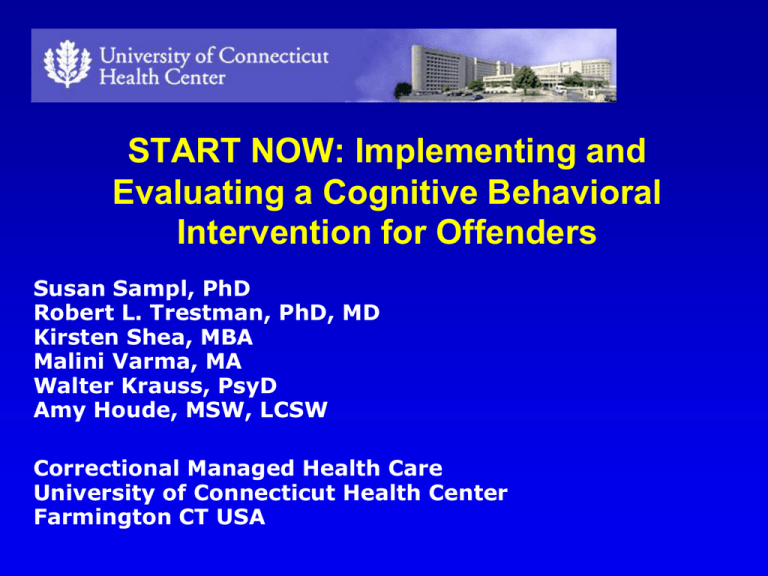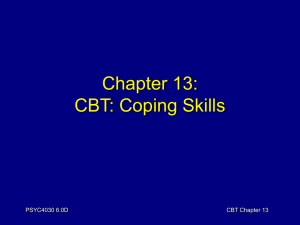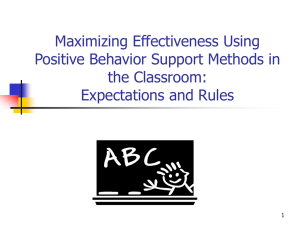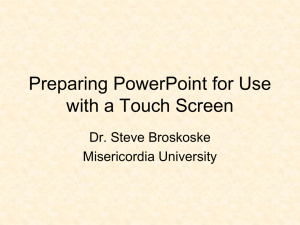NOW - Academic and Health Policy Conference on Correctional
advertisement

START NOW: Implementing and Evaluating a Cognitive Behavioral Intervention for Offenders Susan Sampl, PhD Robert L. Trestman, PhD, MD Kirsten Shea, MBA Malini Varma, MA Walter Krauss, PsyD Amy Houde, MSW, LCSW Correctional Managed Health Care University of Connecticut Health Center Farmington CT USA OBJECTIVES 1.Understand the theoretical and research background of START NOW 2. Articulate recommendations for successfully implementing a structured cognitive behavioral intervention within corrections. 3. Identify methods and results of evaluating START NOW in correctional settings. DISCLOSURE • No financial Conflicts of Interest Using SCID II with 508 inmates in Connecticut jails in an IRB approved National Institute of Justice Study: (Trestman et al, 2007) Personality Disorder Male (N=307) Female (N=201) Total (N=508) Freq % Freq % Freq % Paranoid 29 9.6 20 10.1 49 9.8 Borderline 39 12.9 45 23.2 84 16.9 Antisocial 120 39.5 53 27.0 173 34.6 • Participants: English-speaking women (n=18) and men (n=45) • Results: Significant reduction in targeted behavior was found from baseline to following the16 week DBT-CM skills treatment groups. Both case management and DBT coaching were significant at 12month follow-up. • Conclusions: The study supports the value of DBT-CM for management of aggressive behaviors in prison settings. • PARTICIPANTS: 38 male adolescents • RESULTS: Significant changes were found in physical aggression, distancing coping methods, and number of disciplinary tickets for behavior. • CONCLUSION: The study supports the value of DBT-CM for the management of incarcerated male adolescents with difficult-to-manage aggressive behaviors. CHALLENGES: TRANSITION FROM RESEARCH TO PRACTICE • • • • Costs of training Staff turnover Optimum language level Costs and copyright issues Background of START NOW: Research • START NOW is an evidence-informed coping skills therapy designed to treat offenders with behavioral disorders and associated behavioral problems. • START NOW grew out of National Institute of Justice funded research at the University of CT Health Center and the Connecticut DOC. http://cmhc.uchc.edu/programs_services/startnow.aspx Structure & Design of START NOW • 32 CBT/Coping Skills group sessions • Clinical Tools – Participant workbooks • 5th grade reading level • Gender specific • Spanish version available – Facilitator manual • Highly structured, detailed • Basic scripts and examples provided – Standardized protocol and tools for training and fidelity monitoring Background of START NOW: Theory • An integrative skills training model informed by a number of theoretical approaches & models– Primarily a cognitive behavior therapy (CBT) model – Includes motivational interviewing principles & practices to enhance motivation for change – Infused with elements of cognitive neuro-rehabilitation, in consultation with correctional neuro-cognitive researcher, D. Fishbein (Fishbein et al., 2009). – Theories of criminal behavior, including relevant examples in participant workbooks. CBT for a Correctional Population • There is much support in the literature for the use of CBT in the treatment of criminal conduct (Thigpen, 2007; Wilson, Bouffard, & Mackenzie, 2005). • Several meta analyses support the use of CBT to reduce criminal recidivism (Pearson, Lipton, Cleland, & Yee, 2002). • Group oriented CBT was found to reduce criminal behavior 20-30% compared to control (Wilson, Bouffard, & Mackenzie, 2005). CBT within START NOW • CBT procedures during group: – – – – Brainstorming Role play problem-solving shaping of desired behaviors • “Real life practice exercises” between group sessions • “ABC System” for functional analysis of behavior Incorporating Motivational Interviewing • Focuses on developing motivation for change (Miller & Rollnick, 2002), including changing criminal behavior (Chambers et al., 2008; Howells & Day, 2006). • MI & CBT have been combined in other effective interventions (Dennis et al., 2004; Diamond et al., 2002; Steinberg et al., 2005). • Research supports use of MI with offenders, resulting in improved addictions treatment compliance (Davis et al., 2003), reduced criminal attitude and substance related problems (Harper & Hardy, 2000), reduced reconviction rates (Antiss, Polascek & Wilson, 2011), and reduced DUI behaviors in adolescents (Stein et al., 2006). Motivational Interviewing Influence on START NOW strategies: • Emphasis on accepting ambivalence about change and “rolling with resistance” • “Supporting self-efficacy” through focusing on strengths • Many opportunities to elicit change talk & work through ambivalence are built into the START NOW clinical materials Offender Focused Interventions Influence on START NOW strategies: • Illustrative examples & coping behaviors are relevant to forensic situations • Concepts & language are simplified given cognitive limitations of many offenders • Numerous icons included in the participant workbookespecially useful with TBI or verbally limited participants • Facilitator manual includes numerous tips for engaging difficult-to-engage participants: eg, shaping by reinforcing any movement toward the desired behavioral change. Standard CBT Session Structure • Introduce any new members & review group rules (5 min.) • Review of real life practice exercise from previous session (10 – 15 min.) • Practice Focusing or ABC Skills (10 – 15 min.) • Rationale & overview of new coping skill (10 min.) • In-session practice exercise (15 min.) • Assign new real life practice exercise (5 min.) Unit 1- My Foundation: Starting with Me • Focuses on developing increased self-control & ability to cope with stressors • Includes setting a treatment goal, increasing wellness skills, accepting yourself & your situation, & enhancing your spirituality, values & personal boundaries. Unit 2- My Emotions: Dealing with Upset Feelings Includes: • Recognizing & understanding emotions. • Coping with emotions through actions, or through thoughts & imagery. • Coping with depression, anger, anxiety & grief. Unit 3- My Relationships: Connecting with Others • Focuses on developing positive relationship skills including: – – – – – Listening skills Assertiveness Setting boundaries Asking for support Avoiding destructive relationships – Responding to feedback – Coping with rejection Unit 4- My Future: Setting & Meeting my Goals • Focuses on preparing for a positive future by: – Developing hope – Setting realistic goals & breaking them down into steps – Learning problem solving skills – Learning to set & meet educational & vocational goals Developing & Maintaining Fidelity of Implementation • Training, in absence of coaching, is insufficient. (National Implementation Research Network- Fixsen et al., 2005) • Network of START NOW Trainers developed covering the entire CT DOC system • START NOW Trainer Role: – Serve as local expert & point of communication – Provide centralized and local training – Observe groups for fidelity monitoring & coaching Supporting the Sustainability of START NOW • Enhanced by a standardized manual-guided intervention • Results in reasonable cost of training to allow for staff turnover within corrections • Requires a committed coordinating team, as well as an organized system to track provision of care Creating an Information System DATA! • Repository for resources • Internal • External • Program generated data • Outcome Measures • Methods to retrieve data/Reporting tools http://cmhc.uchc.edu/programs_services/startnow.aspx Program Generated Data • • • • Group Data Attendance Data Program Outcomes Satisfaction Questionnaires Building a data set • Identifying information – Inmate name – Inmate number • Start date of group • End date of group • Number of sessions completed Outcome Measures • Identify available data Outcome Measures • Identify available and relevant data pieces • Disciplinary Tickets • Days spent as MH inpatient • Psychological measure assessment (computerized) • Buss-Perry Aggression Questionnaire • Inventory of Interpersonal Problems • Barrett Impulsiveness Scale Outcome Measures • Target new measures • • • • Self-injurious behaviors Medication adherence Crisis encounters per month Recidivism Method to Retrieve Data / Reporting • Canned reports through MS Access application • Custom reports requested through IT • Data Dashboards (coming soon) START NOW Program • 13 CDOC facilities have active START NOW programs • 57 clinicians are currently trained • 215 individuals are in active treatment Data as of February 28, 2013 START NOW Participant Satisfaction Data Through December 2012 Satisfaction Survey Procedures • • • • N=619 10 questions; 8 Likert Scale, 2 open-ended Completed at the end of every unit Anonymous START NOW Participant Satisfaction Data Q1: How would you rate the quality of the START NOW unit you just completed? 1=Poor, 2=Fair, 3=Good, 4=Excellent Overall N: 619 U1 N: 210 U2 N: 158 U3 N: 127 U4 N: 124 START NOW Participant Satisfaction Data Q5: How satisfied are you with the amount of help you have received? 1=Quite Dissatisfied, 2=Indifferent or mildly dissatisfied, 3=Mostly satisfied, 4=Very satisfied Overall N: 619 U1 N: 210 U2 N: 158 U3 N: 127 U4 N: 124 START NOW Participant Satisfaction Data Q6: Has this START NOW unit helped you to deal more effectively with your problems? 1=No, it seemed to make things worse, 2=No, it really didn’t help, 3=Yes, it helped, 4=Yes, it helped a great deal Overall N: 619 U1 N: 210 U2 N: 158 U3 N: 127 U4 N: 124 START NOW Participant Satisfaction Data Q7: Has participation in this START NOW unit helped you cope with daily life in prison/jail? 1=No, it seemed to make things worse, 2=No, it really didn’t help, 3=Yes, it helped, 4=Yes, it helped a great deal Overall N: 619 U1 N: 210 U2 N: 158 U3 N: 127 U4 N: 124 START NOW Participant Satisfaction Data Q8: If you were to seek help again would you participate in this START NOW unit? 1=No, definitely not, 2=No, I don’t think so, 3=Yes, I think so, 4=Yes, definitely Overall N: 619 U1 N: 210 U2 N: 158 U3 N: 127 U4 N: 124 START NOW Participant Satisfaction Data Q9: What were the activities or topics you liked the most about this unit? An open-ended question for which responses were categorized through qualitative analysis. Frequencies of the top 6 responses are shown below: Overall N: 615 START NOW Participant Satisfaction Data Q10: What would you change about this unit to make it better? An open-ended question for which responses were categorized through qualitative analysis. Frequencies of the top 6 responses are shown below: 250 200 150 100 50 0 Overall N: 506 ADAPTATION of START NOW Alternative to Incarceration (AIC) Program • DMHAS AIC program for Dually- Diagnosed SMI clients (ASIST) • Significant effect for START NOW on reduced re-incarceration (b=-.024, S.E.=0.008, p=0.003, OR=0.98); Cox regression, adjusted for illness severity • Dose Response: Each START NOW session yields a 2.0% reduction in the odds of reincarceration • Frisman LK, Lin H, Rodis E, & Grzelak J. Final Report: Evaluation of the ASIST Program. CT Department of Mental Health & Addiction Services, internal document, 9/12/11 SUMMARY • These interventions have a role to play in empowering individuals to gain greater control over their lives as they work toward recovery and effective integration into the community • Implementation of evidence-based or evidenceinformed treatment has many real world challenges that can be met both in institutional correctional and forensic settings







